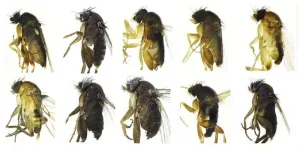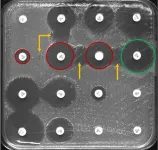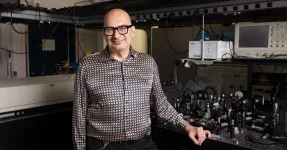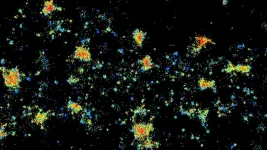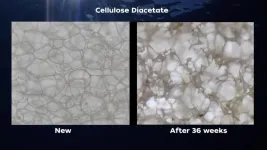(Press-News.org) COLUMBUS, Ohio – The microbes that cycle nutrients in the ocean don’t do the work on their own – the viruses that infect them also influence the process. It’s a vital job for the rest of the planet, enabling oceans to absorb half of the human-generated carbon in the atmosphere and produce half of the oxygen we breathe.
A new study gets scientists closer to more fully understanding where viruses fit into the global ocean picture of cycling nutrients such as nitrogen, phosphorous and, of particular interest, carbon. The research broadly expands on a 20-year-old finding that genes can be exchanged between viruses and the photosynthetic cells they infect and consolidates data resulting from more than 100 papers on viruses and metabolism that followed.
The research team, led by The Ohio State University, reports in the journal Microbiome on its creation of a catalog of genes that viruses “stole” from the marine microbes they infected across all of the world’s oceans. Scientists identified and organized almost 23,000 genes known as auxiliary metabolic genes (AMGs), including over 7,000 never previously documented. The analysis suggests that about 1 in 5 ocean virus populations carries at least one AMG.
Adding even more context to the viruses’ role, the researchers mapped 340 metabolic pathways attributed to microbes in the oceans – changes to the nutrient balance resulting from organisms consuming and generating molecules based on their survival needs. Of those, the scientists found that viral AMGs mapped to 128 pathways – meaning viruses affected over 37% of those processes.
“We still don’t know the extent of viruses’ impact. But now that we know the pathways that viruses target via AMGs, we could use metabolic modeling approaches to quantitatively estimate the viral impact on the host communities and ocean functioning,” said first study author Funing Tian, who completed the work as a PhD student in microbiology at Ohio State.
“Future modeling work could involve increasing or decreasing metabolic fluxes occurring through these pathways and seeing how the impact of viruses would change.”
Tian and her co-lead author, former Ohio State microbiology postdoctoral scholar James Wainaina, focused on DNA viruses that infect prokaryotes: bacteria and other single-celled organisms floating throughout the world’s oceans.
Wainaina and Tian were members of the lab led by the study’s senior author, Matthew Sullivan, professor of microbiology and founding director of the Center of Microbiome Science at Ohio State.
Sullivan was the virus coordinator for the Tara Oceans Consortium, a three-year global study of the impact of climate change on the world’s oceans. As part of that international collaboration, he has led previous work to catalog close to 200,000 DNA and 5,500 RNA virus species in the oceans, and to ascertain viruses’ potential to mitigate climate change.
Tian and Wainaina analyzed 7.6 terabytes of Tara Oceans metagenomic sequence data for this study, increasing the known ocean DNA virus populations to 579,904. From these populations, the team took many computational steps to identify the auxiliary metabolic genes located in virus genomes.
They conservatively identified a total of 86,913 AMGs that grouped into 22,779 sequence-based gene clusters. Of those, 7,248 were identified for the first time. Viruses lift these genes from the microbial cells they infect and incorporate the genes into their own genome – giving them the power to reprogram a host cell’s function in a way that ensures viral survival.
“The challenge with auxiliary metabolic genes is that people know they’re there, but the gene is similar to the cellular copy – that makes it important to differentiate between the viral copy and the microbial copy,” Wainaina said.
“To minimize false positives, we undertook curation steps to make sure we focused only on AMGs that were on viral genome segments,” Tian said.
They then further analyzed the genomic data to determine metabolic pathways – each one a series of related actions that alter a cell’s function – that could be traced to specific microbial species, revealing 340 such pathways. With their new catalog of “stolen” genes, the researchers found that 128 of these pathways were targeted by viral AMGs.
“That’s our big finding,” Tian said. “Before this paper, it was unknown how many metabolic pathways were encoded in microbes throughout the global oceans, and even less understood among those how many were targeted by viruses via AMGs.”
Added Wainaina, “It’s not only about the number, but also which specific pathways viruses are involved in – that informs the biogeochemical cycles viruses are reprogramming and manipulating in the ocean.”
The AMG catalog and metabolic pathway mapping provide a foundation for microbiome engineering experimentation and modeling that will help researchers make more accurate predictions about viruses’ roles in ocean biogeochemical processes, Sullivan said.
“Most current models don’t include viruses at all, and only some include microbes,” he said. “It’s exciting that we’ve generated these data that are critical for bringing viruses and their impacts into new predictive models.”
This work was supported by the National Science Foundation, the Gordon and Betty Moore Foundation, the Natural Sciences and Engineering Research Council of Canada, the Canada Foundation for Innovation, the G. Unger Vetlese and Ambrose Monell Foundations, and the Ohio Supercomputer Center.
Tian is now a bioinformatician at the University of Chicago, and Wainaina is an assistant scientist in the Biology Department at Woods Hole Oceanographic Institution. Additional co-authors include Cristina Howard-Varona, Guillermo Domínguez-Huerta, Benjamin Bolduc, Garrett Smith, Marissa Gittrich, Olivier Zablocki and Dylan Cronin of Ohio State; Maria Consuelo Gazitúa of Viromica Consulting; Damien Eveillard of Nantes Université; and Steven Hallam of the University of British Columbia.
#
Contacts:
Funing Tian, funing.tian@bsd.uchicago.edu
James Wainaina, james.wainaina@whoi.edu
Matthew Sullivan, Sullivan.948@osu.edu
Written by Emily Caldwell, Caldwell.151@osu.edu
END
WASHINGTON (Oct. 17, 2024) -- The U.S. Centers for Disease Control and Prevention (CDC) and the President’s Emergency Plan for AIDS Relief (PEPFAR), have awarded $27.5 million to the Center for Global Health Practice and Impact (CGHPI) at Georgetown University Medical Center to expand its ongoing work in Haiti to address HIV/AIDS.
For the 150,000 people in Haiti living with HIV, losing access to basic life-saving therapy can lead to unnecessary suffering, risk of transmission to others, and ...
The Earth is an almost unimaginably diverse planet in terms of species. Researchers have identified between two and three million species, but there are many more that we know nothing about.
The unknown species are called ‘biological dark matter’, borrowing a term from astrophysics.
“We want to demonstrate how we can gain a better overview of biological dark matter by using DNA barcoding,” said Associate Professor Emily Hartop.
DNA barcoding, in this case so-called ‘megabarcoding’, might sound mysterious, but it isn’t really. We will come back to that later. First, let us take a look at why ...
WASHINGTON — Americans believe volunteering to help strangers contributes more to society than providing care for family or friends, even though they contribute billions of dollars’ worth of labor in unpaid caregiving every year, according to research published by the American Psychological Association.
This perception could lead Americans of lower socioeconomic status to feel like they have less to contribute than people of higher socioeconomic status, because they often do not have the same amount of time or resources to devote to people outside of their communities.
“Over ...
Researchers at the University of Zurich (UZH) have used artificial intelligence (AI) to help identify antibiotic-resistant bacteria. The team led by Adrian Egli, UZH professor at the Institute of Medical Microbiology, is the first to investigate how GPT-4, a powerful AI model developed by OpenAI, can be used to analyze antibiotic resistance.
The researchers used AI to interpret a common laboratory test known as the Kirby-Bauer disk diffusion test, which helps doctors to determine which antibiotics can or can’t fight a particular bacterial infection. Based on GPT-4, the scientists created the “EUCAST-GPT-expert”, which follows strict EUCAST ...
WASHINGTON—The Endocrine Society, a global organization that promotes endocrinology research and clinical practice, and Keystone Symposia, a nonprofit host of conferences and symposia on a range of life science and biomedical topics, will jointly host a series of three conferences to advance endocrine research.
The three conferences will focus on diabetes, oncology and cardiovascular disease—hormone-related conditions that have a major impact on public health. The conference series is slated to launch in late 2026 or early 2027 and will run ...
Quantum research breakthrough uses synthetic dimensions to efficiently process quantum information
The discovery, at INRS, of a synthetic photonic lattice capable of generating and manipulating quantum states of light, offers promising prospects for a variety of applications, from quantum computing to secure quantum communication protocols.
A study co-directed by Professor Roberto Morandotti of Institut national de la recherche scientifique (INRS) in collaboration with teams from Germany, Italy, and Japan opens the door to cutting-edge solutions ...
Imagine you wake up in a hospital without a single memory of the last month. Doctors say you had a series of violent episodes and paranoid delusions. You’d become convinced you were suffering from bipolar disorder. Then, after a special test, a neurologist diagnoses you with a rare autoimmune disease called anti-NMDAR encephalitis. This is what happened to Susannah Cahalan, a New York Post reporter who would go on to write the best-selling memoir Brain on Fire: My Month of Madness.
Anti-NMDAR encephalitis can lead to hallucinations, blackouts, and ...
Woods Hole, Mass.(Oct. 17, 2024) — Scientists at the Wood Hole Oceanographic Institution (WHOI) have been working for years to find out what types of plastics have the shortest and longest lifespans in the ocean, and what types of plastic products, like straws and food wrappers, most commonly contribute to plastic pollution. With more biodegradable materials being developed , like cellulose diacetate (CDA)—a plastic-like polymer derived from wood pulp—researchers are racing to ensure they can replace traditional plastics without causing harm to ocean ...
(October 17, 2024) - Philadelphia, PA - Rapid advancements across industries from healthcare, technology, finance and beyond present novel opportunities as well as challenges. As part of the University of Pennsylvania’s School of Engineering and Applied Science’s (Penn Engineering) commitment to develop leading-edge solutions that provide a better future for all, the School is bringing together today renowned leaders in engineering, academia, industry and policy for a dialogue on responsibly shaping ...
With cardiovascular disease remaining a leading cause of death worldwide, a new study has highlighted strawberries as a natural and delicious way to support heart health and manage cholesterol. This research revealed significant health benefits associated with regular consumption of strawberries between (1 and 4 cups per day), particularly in improving cardiometabolic health.
Conducted by researchers from the University of California, Davis and funded by the California Strawberry Commission, the literature review, published in the September 2024 issue of ...
